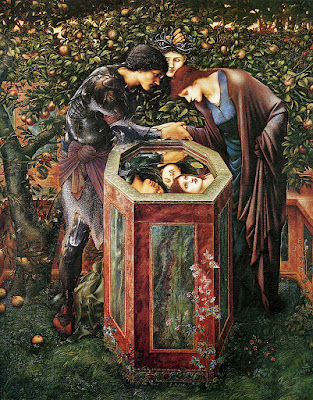NOTE: Since these poems have more historical detail than the previous ones, I thought I would provide a few notes to help you along. Ultimately, these are poems with very unreliable narrators who tell stories about themselves which betray greed, avarice, self-righteousness, and blind indifference to their fellow man. The questions follow after these notes.
JOHANNES AGRICOLA IN MEDITATION
* Agricola was a 14th century religious philosopher who founded a sect called the Antinomians, who believed in strict predestination. If someone was holy, they were going to heave no matter what; similarly, someone damned was damned from birth and no amount of good works could save them. So this "meditation" is his dramatic monologue about the nature of his existence.
SOLILOQUY OF THE SPANISH CLOISTER
* Takes place in a monastery in Spain sometime around the 18th or 19th century (we can only tell because the narrator mentions owning a French novel, which didn't come around until the 1720's or so), and concerns the rivalry between the narrator and his fellow monk, Brother Lawrence.
* Salve tibi: a greeting in Latin, as the monks would speak amongst themselves
* Swine's Snout: the botanical name for the dandelion, but here it has a double meaning!
* the Arian: or Arius, a 4th century heretic who rejected the Trinity (hence, the narrator drinks his watered orange-pulp in three sips)
* Galatian: St. Paul's Epistle to the Galatians, though he's making up the so-called "great text of damnations" (or it suggests he doesn't know the Bible as well as he thinks!)
* French novel: these were synonymous with pornography. So the narrator owns a pornographic novel.
* Belial: a name for the Devil
* Hy, Zine, Hine: a magic spell like "abracadabra"
* Plena gratia, Ave virgo: Hail Virgin, full of grace
THE BISHOP ORDERS HIS TOMB AT SAINT PRAXTED'S CHURCH
* A bishop, on his death bed, has gathered his sons (both actual and illegitimate) around him to order his tomb, and to frustrate his recently-deceased rival, Gandolf, who is also buried in the church. His mind is going, so he rants and raves all over the place, revealing much about his life and his 'holy' pursuits.
* onion-stone: poor-quality marble
* lapis lazuli: semi-precious stone with a deep blue color--very prized in the ancient world
* antique-black: high-quality marble
* travertine: ordinary stone used for building
* Tully: Cicero, a Roman statesman and scholar. famous for his beautiful use of Latin
* Ulpian: a poor-man's Cicero!
* ELUCESCEBAT: "to shine forth" in Latin; the Bishop seems to suggest that the word is on Gandolf's tomb, and scoffs, since Tully (Cicero) would have written better Latin
Answer TWO of the following:
Q1: All three poems focus on religious figures, all of whom are in a position of power or prestige (though less so in the Spanish Cloister). What makes each one satirical? How can we tell that each one is supposed to poke fun at the supposed holiness and austerity of the clergy?
Q2: "The Soliloquy of the Spanish Cloister" veers very close to a Poe short story, and indeed, Poe was writing his own stories at the same time (this poem appeared in 1842, and a similar story, "The Cask of Amontillado" appeared in 1846). If you know Poe's stories, what makes this narrator such a prototypically "Poe" narrator? What makes him unreliable, though he certainly seems to be honest about his hatred? Where does he slip and reveal too much to the reader?
Q3: How might we see something of Victor Frankenstein (and more literally, William Godwin) in the narrator of "Johannes Agricola in Meditation"? Why might such a man also decide to make monsters and devils without fear or reprieve?
Q4: Though the Bishop doesn't kill anyone (his rival seems to die of natural causes, as does his wife--I think!), he shares a lot in common with the Duke of "My Last Duchess." What makes him such a merciless figure, despite his age and mental fragility? Related to this, why might many of his children be standing back rather than holding his hand as he drifts off into death?


























